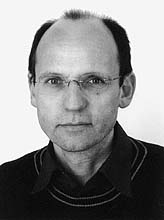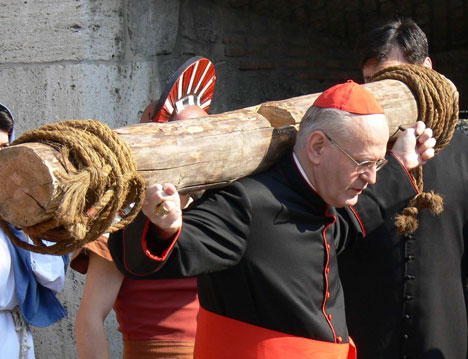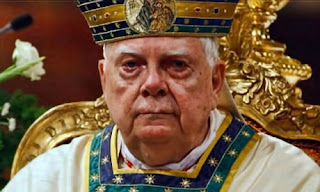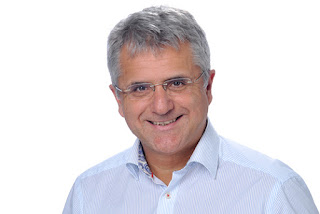Pope personally expelled heretics from pilgrimage shrine - with video
This newspaper walked this week through holy land. It will be 376 years since the only Eucharistic miracle occurred in the country, but this time it will be different for Eten. Its main driving force, seeking formal recognition by the Vatican as a miracle, now leads the sacred institution. Thus, the hope of its parishioners grows. It's a decades-long struggle.
A Eucharistic miracle is an extraordinary event related to the consecration of bread and wine into the body and blood of Christ during Mass, which cannot be explained by natural causes and which the Church considers a direct manifestation of God.
“When a Corpus Christi Eve Mass was being celebrated here on June 2 (1649) in our mother church, which is now buried and located near the beach, the Child Jesus appeared in the consecrated host. A small child with curly blond hair wearing a purple cape. Everyone was excited. This miracle was repeated before the eyes of four preachers on July 22, 1649, when Mass was being celebrated in honor of our patron saint, Mary Magdalene,” recounts Jesús León Ángeles, current coordinator of the Eucharistic Miracle Peru 1649 group, who welcomed us this week at the main parish of Eten, Santa María Magdalena.
Years later, in 1773, a Lambayecan fisherman, Manuel del Castillo, was at sea when a storm suddenly struck. “He invoked this miracle, this child, and told him that if the sailboat didn't sink, he would build a chapel for him,” León recalls. And so, in 1778, del Castillo gave Eten a chapel near the sea and very close to the main church that had witnessed the events more than a hundred years earlier.
The place where the miracle occurred is now underground due to the work of nature. Currently, a chapel stands there, which we also visited, but which a few years ago was the scene of a public confrontation between the then-Bishop Robert Prevost and some false priests who had taken over the place for commercial purposes.
A wooden panel stands at the entrance to the Maria Magdalena Parish in the city of Eten. At this spot, Bishop Prevost held Mass and reminded people of the importance of more people knowing about the Divine Child of the Miracle.
“I come to this chapel and they close the door on me. Those supposed priests should know that without the bishop's authorization there is no Catholic Mass. Don't be fooled,” Robert Prevost said loudly on the morning of July 23, 2018, to some residents at the site of the two apparitions of the Divine Child of the Miracle.
“When have you been here before?” one of the false priests' defenders replied.
“Brothers and sisters, it is my duty as bishop of the diocese to care for Catholic worship. I have been given photographs of supposed priests. You have had La Industria (a newspaper in Chiclayo) publish false news,” Bishop Prevost declared.
The incident was recorded in a police report and in a previously unseen video, as the merchants' defenders and false priests expelled the now Pope Leo XIV from the premises.
This unfortunate event did not prevent Prevost from continuing to push the Vatican for official recognition of the miracle. Yesterday, the newspaper El Peruano published the law that "declares the recognition of Eten, located in the district of Ciudad Eten in the province of Chiclayo, in the department of Lambayeque, as a Eucharistic city of national interest, within the framework of Decree Law 23211, which approves the 'Agreement between the Holy See and the Republic of Peru.'" With this, it is hoped that construction will also begin on the shrine of the Divine Child of the Miracle on a plot of land measuring more than 10 hectares, which the then bishop arranged for it to be a center of pilgrimage and faith.
If this recognition is achieved, not only Eten, but also Chiclayo and the entire Lambayeque region—with its dry goat and fried rice—will be a key destination for religious tourism, attracting millions of people from around the world each year.
Robert Prevost's Favorite Chapel in Piura
In 1985, this place, known as the gateway to Upper Piura, was the first to host church services for the American Robert Prevost, better known in Chulucanas as Father Roberto. Much has been said about the work that Leo XIV left in the north of the country, but very little is known about his ecclesiastical and pastoral preferences.
Fifteen minutes from Chulucanas, along a half-paved road, lies the hamlet of Yapatera and its Santa Rosa church.
Father Roberto didn't like to stay in his parish. His essence, originating in the Order of Saint Augustine, was always at the side of those who needed him most. He went to them, he was a pilgrim priest. “The Augustinian charism is communion, service to the Church, going beyond; the people of God aren't going to come. Roberto sent us house to house to create zones,” says Fidel Alvarado, vicar of the Diocese of Chulucanas and parish priest of the San Agustín church in La Matanza, with whom we spoke this week.
So, Father Roberto went to the places where he was truly needed. In 1985, he didn't stay in the city of Chulucanas. Fifteen minutes away, along a half-paved road, lies the hamlet of Yapatera and its church, Santa Rosa. Héctor Camacho was an altar boy there alongside Father Roberto, who years later would become his godfather. “We formed a group of altar boys. He kept us busy, gave us extra education, and instilled in us a love of Christ,” Camacho recalls.
Yapatera is a community of African descent. Poverty is evident, but despite this, the joy of its people and, above all, their faith make this town the perfect place to remember that God lives here, where they need him most. “When they left, they would wait for Father Roberto and, as is customary here, they would prepare lunch: cabrito (goat), pepián (pepián). The priest ate well, and they gave him his chicha (de jora) and Father Roberto would drink it,” says the former altar boy.
Another town, 20 minutes from Chulucanas, is La Matanza. There stands a church that Prevost helped build. Perú21 arrived during the 4:00 p.m. Mass last Tuesday. An unusual time for Mass, but customary in the town. However, the 30-degree temperature is no impediment to his community's encounter with faith. During the liturgy, parish priest Fidel Alvarado recalls that Robert Prevost also walked here and left his mark.
Héctor Camacho was an altar boy there alongside Father Roberto, who years later would become his godfather.
In front of El Señor Cautivo de Ayabaca, Father Alvarado recounts Prevost's admiration for this image so venerated in northern Peru. "Roberto encouraged us to attend the processions of these devotions to grow in love for God and love for our neighbors. This popular religiosity has been encouraged and cultivated," says Father Alvarado. "Roberto was very much a part of popular religiosity; he loved these signs of God in his town. He has been to the sanctuary of Ayabaca. El Señor Cautivo is the biggest festival in the north," says the parish priest of La Matanza.
Before leaving Chulucanas, Father Fidel Alvarado, very happy, mentioned that the mayor had called him to begin designing a tourist route featuring the favorite places and saints that Leo XIV visited at the gateway to Alto Piura.













.jpeg)

Comments